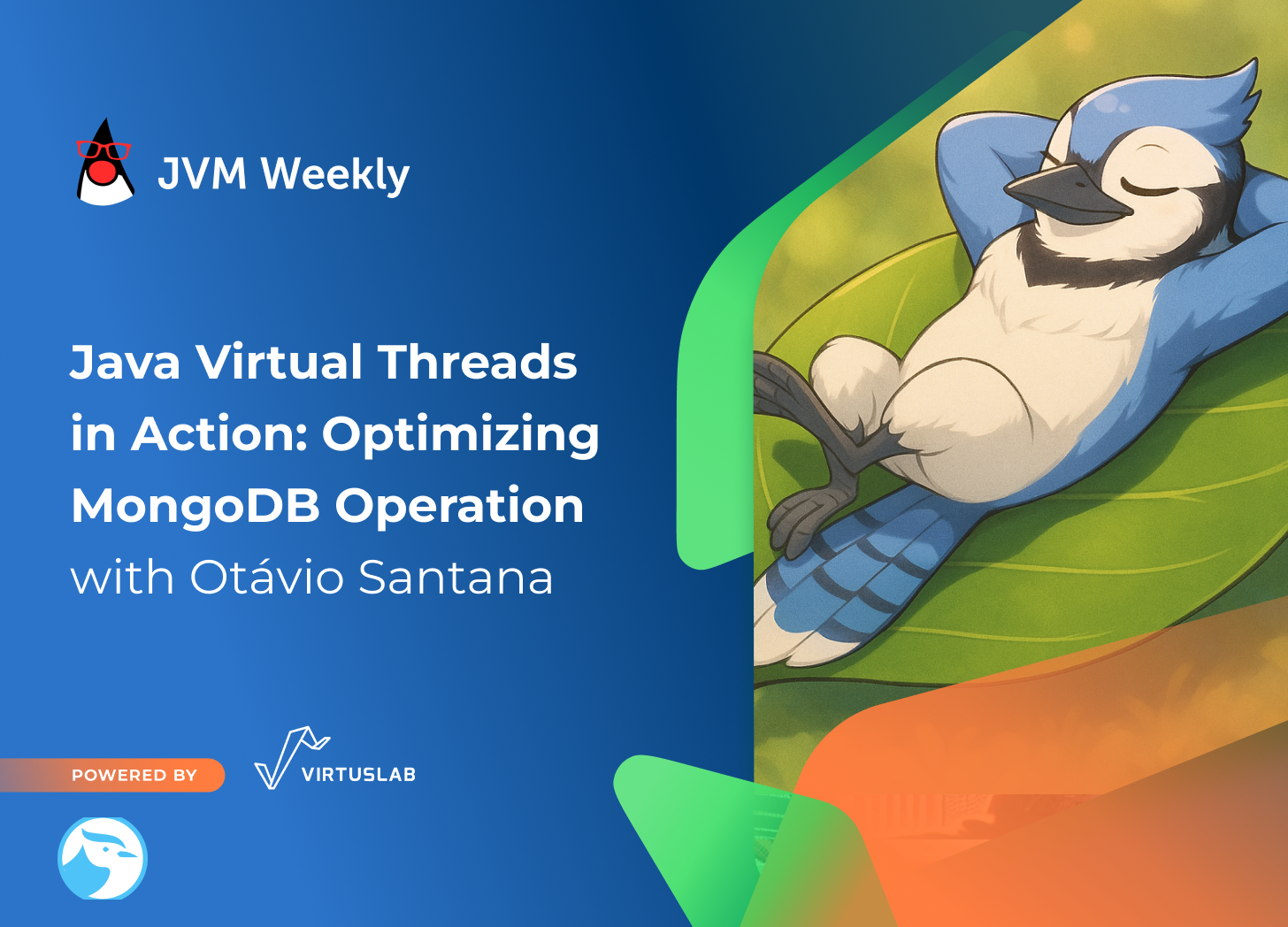"Java Virtual Threads in Action: Optimizing MongoDB Operation" with Otávio Santana - JVM Weekly vol. 140
Today, we have a guest post from Otavio Santana about everyones favourite feature -Virtual Threads.
Last May, I announced that JVM Weekly had joined the Foojay.io family. Foojay.io is a dynamic, community-driven platform for OpenJDK users, primarily Java and Kotlin enthusiasts. As a hub for the “Friends of OpenJDK,” Foojay.io gathers a rich collection of articles written by industry experts and active community members, offering valuable insights into the latest trends, tools, and practices within the OpenJDK ecosystem.
So like last month, I have something special - a repost of a great JVM-related article, originally posted on Foojay.io. Today, we have a guest post about Virtual Threads and MongoDB from Otávio Santana, Java Champion and author of Mastering the Java Virtual Machine.
Java Virtual Threads in Action: Optimizing MongoDB Operation
Virtual threads have become one of the most popular resources in Java and are trending inside the language. Indeed, this resource introduced a cheap way to create threads inside the JVM. In this tutorial, we will explain how to use it with MongoDB.
You can find all the code presented in this tutorial in the GitHub repository:
git clone git@github.com:soujava/mongodb-virtual-threads.git
Prerequisites
For this tutorial, you’ll need:
Java 21.
Maven.
A MongoDB cluster.
MongoDB Atlas (Option 1)
Docker (Option 2)
A Quarkus project with MongoDB integrated.
You can use the following Docker command to start a standalone MongoDB instance:
docker run --rm -d --name mongodb-instance -p 27017:27017 mongo
Java 21 has introduced a new era of concurrency with virtual threads—lightweight threads managed by the JVM that significantly enhance the performance of I/O-bound applications. Unlike traditional platform threads, which are directly linked to operating system threads, virtual threads are designed to be inexpensive and can number in the thousands. This enables you to manage many concurrent operations without the typical overhead of traditional threading.
Virtual threads are scheduled on a small pool of carrier threads, ensuring that blocking operations - such as those commonly encountered when interacting with databases - do not waste valuable system resources.
In this tutorial, we will generate a Quarkus project that leverages Java 21’s virtual threads to build a highly responsive, non-blocking application integrated with MongoDB via Eclipse JNoSQL. The focus is on exploring the benefits of virtual threads in managing I/O-bound workloads and illustrating how modern Java concurrency can transform database interactions by reducing latency and improving scalability.
As a first step, follow the guide, MongoDB Developer: Quarkus & Eclipse JNoSQL. This will help you set up the foundation of your Quarkus project. After that, you'll integrate Java 21 features to fully exploit the power of virtual threads in your MongoDB-based application.
During the creation process, ensure you generate the project's latest version on both Quarkus and Eclipse JNoSQL. Make sure that you have a version higher than:
<dependency>
<groupId>io.quarkiverse.jnosql</groupId>
<artifactId>quarkus-jnosql-document-mongodb</artifactId>
<version>3.3.4</version>
</dependency>In this tutorial, we will generate services to handle cameras. We will create cameras based on Datafaker and return all the cameras using virtual threads with Quarkus. In your project, locate the application.properties file (usually under src/main/resources) and add the following line:
# Define the database name
jnosql.document.database=camerasWith this foundation, we'll move on to implementing the product entity and explore how MongoDB's embedded types can simplify data modeling for your application.
Step 1: Create the Product entity
To start, we’ll define the core of our application: the Camera entity. This class represents the camera data structure and contains fields such as id, brand, model, and brandWithModel. We will have a static factory method where, based on the Faker instance, it will generate a Camera instance.
import jakarta.nosql.Column;
import jakarta.nosql.Entity;
import jakarta.nosql.Id;
import net.datafaker.Faker;
import java.time.LocalDate;
import java.util.Objects;
import java.util.UUID;
@Entity
public record Camera(
@Id @Convert(ObjectIdConverter.class) String id,
@Column String brand,
@Column String model,
@Column String brandWithModel
) {
public static Camera of(Faker faker) {
var camera = faker.camera();
String brand = camera.brand();
String model = camera.model();
String brandWithModel = camera.brandWithModel();
return new Camera(UUID.randomUUID().toString(), brand, model, brandWithModel);
}
public Camera update(Camera request) {
return new Camera(this.id, request.brand, request.model, request.brandWithModel);
}
}Explanation of annotations:
@Entity: Marks the Product class as a database entity for management by Jakarta NoSQL.@Column: Maps fields (name, manufacturer, tags, categories) for reading from or writing to MongoDB.
Step 2: Create the Service
In our application, the CameraService class serves as a bridge between our business logic and MongoDB. We utilize Eclipse JNoSQL, which supports Jakarta NoSQL and Jakarta Data. In this tutorial, we work with the DocumentTemplate interface from Jakarta NoSQL—a specialized version of the generic Template interface tailored for NoSQL document capabilities. The Quarkus integration makes it easier once you, as a Java developer, need to use an injection annotation.
Furthermore, we inject an ExecutorService that is qualified with the @VirtualThreads annotation. This annotation instructs Quarkus to provide an executor that employs Java 21's virtual threads for improved concurrency.
Define a CameraService to interact with MongoDB:
import io.quarkus.virtual.threads.VirtualThreads;
import jakarta.enterprise.context.ApplicationScoped;
import jakarta.inject.Inject;
import net.datafaker.Faker;
import org.eclipse.jnosql.mapping.document.DocumentTemplate;
import java.util.List;
import java.util.Optional;
import java.util.concurrent.ExecutorService;
import java.util.logging.Logger;
@ApplicationScoped
public class CameraService {
private static final Logger LOGGER = Logger.getLogger(CameraService.class.getName());
private static final Faker FAKER = new Faker();
@Inject
DocumentTemplate template;
@Inject
@VirtualThreads
ExecutorService vThreads;
public List<Camera> findAll() {
LOGGER.info("Selecting all cameras");
return template.select(Camera.class).result();
}
public List<Camera> findByBrand(String brand) {
LOGGER.info("Selecting cameras by brand: " + brand);
return template.select(Camera.class)
.where("brand")
.like(brand)
.result();
}
public Optional<Camera> findById(String id) {
var camera = template.find(Camera.class, id);
LOGGER.info("Selecting camera by id: " + id + " find? " + camera.isPresent());
return camera;
}
public void deleteById(String id) {
LOGGER.info("Deleting camera by id: " + id);
template.delete(Camera.class, id);
}
public Camera insert(Camera camera) {
LOGGER.info("Inserting camera: " + camera.id());
return template.insert(camera);
}
public Camera update(Camera update) {
LOGGER.info("Updating camera: " + update.id());
return template.update(update);
}
public void insertAsync(int size) {
LOGGER.info("Inserting cameras async the size: " + size);
for (int index = 0; index < size; index++) {
vThreads.submit(() -> {
Camera camera = Camera.of(FAKER);
template.insert(camera);
});
}
}
}In this code:
The DocumentTemplate provides the necessary operations (CRUD) to interact with MongoDB.
The vThreads ExecutorService, annotated with @VirtualThreads, submits tasks that insert fake camera records asynchronously. This is a prime example of how virtual threads can be leveraged for I/O-bound operations without manual thread management.
This setup shows how Quarkus and Eclipse JNoSQL simplify the development process: You get the benefits of Jakarta NoSQL for MongoDB without the boilerplate, and virtual threads allow you to write scalable, concurrent applications in a natural, synchronous style.
For more details on using virtual threads in Quarkus, check out the Quarkus Virtual Threads Guide.
Step 3: Expose the Camera API
We’ll create the CameraResource class to expose our data through a RESTful API. This resource handles HTTP requests. We will generate a camera either manually or using the asynchronous resource. You can define the size of the cameras generated, with the default being 100.
Create a CameraResource class to handle HTTP requests:
import io.quarkus.virtual.threads.VirtualThreads;
import jakarta.inject.Inject;
import jakarta.ws.rs.Consumes;
import jakarta.ws.rs.DELETE;
import jakarta.ws.rs.DefaultValue;
import jakarta.ws.rs.GET;
import jakarta.ws.rs.POST;
import jakarta.ws.rs.PUT;
import jakarta.ws.rs.Path;
import jakarta.ws.rs.PathParam;
import jakarta.ws.rs.Produces;
import jakarta.ws.rs.QueryParam;
import jakarta.ws.rs.WebApplicationException;
import jakarta.ws.rs.core.MediaType;
import jakarta.ws.rs.core.Response;
import java.util.List;
@Path("cameras")
@Consumes({MediaType.APPLICATION_JSON})
@Produces({MediaType.APPLICATION_JSON})
public class CameraResource {
@Inject
CameraService service;
@GET
@VirtualThreads
public List<Camera> findAll() {
return service.findAll();
}
@GET
@Path("brand/{brand}")
public List<Camera> listAll(@PathParam("brand") String brand) {
if (brand == null || brand.isBlank()) {
return service.findAll();
}
return service.findByBrand(brand);
}
@POST
public Camera add(Camera camera) {
return service.insert(camera);
}
@Path("{id}")
@GET
public Camera get(@PathParam("id") String id) {
return service.findById(id)
.orElseThrow(() -> new WebApplicationException(Response.Status.NOT_FOUND));
}
@Path("{id}")
@PUT
public Camera update(@PathParam("id") String id, Camera request) {
var camera = service.findById(id)
.orElseThrow(() -> new WebApplicationException(Response.Status.NOT_FOUND));
return service.update(camera.update(request));
}
@Path("{id}")
@DELETE
public void delete(@PathParam("id") String id) {
service.deleteById(id);
}
@POST
@Path("async")
public Response insertCamerasAsync(@QueryParam("size") @DefaultValue("100") int size) {
service.insertAsync(size);
return Response.accepted("Insertion of " + size + " cameras initiated.").build();
}
}Step 4: Build and run the application
It’s finally time to integrate everything and run the application. After packaging the project with Maven, start the application and ensure that MongoDB runs locally or through MongoDB Atlas. Once the application runs, you can test the API endpoints to interact with the camera data.
Make sure MongoDB is running (locally or on MongoDB Atlas). Then, build and run the application:
mvn clean package -Dquarkus.package.type=uber-jar
java -jar target/mongodb-virtual-thread-1.0.1-runner.jarStep 5: Test the API
Create a Camera
curl -X POST -H "Content-Type: application/json" -d '{
"brand": "Canon",
"model": "EOS 5D Mark IV",
"brandWithModel": "Canon EOS 5D Mark IV"
}' http://localhost:8080/camerasGet all Cameras
curl -X GET http://localhost:8080/camerasGet Cameras by Brand
curl -X GET http://localhost:8080/cameras/brand/CanonGet a Camera by ID
curl -X GET http://localhost:8080/cameras/{id}Update a Camera by ID
curl -X PUT -H "Content-Type: application/json" -d '{
"brand": "Nikon",
"model": "D850",
"brandWithModel": "Nikon D850"
}' http://localhost:8080/cameras/{id}Delete a Camera by ID
curl -X DELETE http://localhost:8080/cameras/{id}Insert Cameras asynchronously
This endpoint triggers the asynchronous insertion of fake camera records. The size parameter defaults to 100 if you omit it.
curl -X POST http://localhost:8080/cameras/async?size=100Conclusion
Java 21's virtual threads simplify handling I/O-bound operations, allowing for massive concurrency with minimal overhead. By integrating virtual threads with MongoDB and Quarkus while maintaining a clean, synchronous programming model, we built a scalable and responsive application.
Ready to explore the benefits of MongoDB Atlas? Get started now by trying MongoDB Atlas.
Access the source code used in this tutorial.
And now, let's review some of the other cool things that appeared on Foojay.io last month.
Foojay Podcast #76: DevBcn Report
As usual, we’re starting with the Foojay podcast: in episode #76 (“DevBcn Report, Part 1”), it’s not Frank Delporte this time - Geertjan Wielenga grabs the mic and, together with organizers Nacho Cougil and Jonathan Vila, interviews a crowd of guests about their Java experience. I especially recommend the history of the DevBCN conference told by Nacho Cougil himself and Jakub Marchwicki (00:45), and for the “language news” it’s worth checking out 47:36, where Luis Majano and Cris Escobar talk about BoxLang - a fresh dynamic language on the JVM.
And this is not a topic which happen every day. Neat.
CodeRabbit Tutorial for Java Developers
In CodeRabbit Tutorial for Java Developers, Aravind Putrevu with a little help of Geertjan Wielenga (check screenshots) offered a hands-on primer to CodeRabbit for Java teams: what it does (and it does AI pull-request reviews 😉), how to set it up across GitHub/GitLab/Azure/Bitbucket, and the core checks it runs - style/best-practices, security pitfalls, performance hints, and design-pattern recognition - with example review comments and “apply suggestion” workflows.
They also show Java-specific config via a .coderabbit.yaml, lightweight Maven/Gradle awareness (deps, updates, CVEs), and “advanced” moves like custom prompts, architectural reviews, and test advice, then wrap with team best practices, common Spring/JPA/Streams patterns it understands, troubleshooting tips, and metrics to prove it’s reducing bugs and speeding reviews.
Aravind is a Director of Developer Marketing in CodeRabbit so he can be “a bit” biassed (sorry Aravind), but I need to say that we are experimenting a lot with different tools in VirtusLab, and while a bit chatty, using CodeRabbit is truly great and useful 😊. Our own product teams are using it and it’s truly helpful, so I recommend you to at least try.
Understanding MCP Through Raw STDIO Communication
In his Foojay article “Understanding MCP Through Raw STDIO Communication”, David Parry peels away SDKs to show how the Model Context Protocol really works by implementing a Java MCP server that speaks plain JSON-RPC 2.0 over stdin/stdout - covering the init handshake, a tiny record-based message model, an event-driven IO loop with thread-safe logging (stdout for messages, files for logs), and why STDIO is a pragmatic default (universal, debuggable, no networking fuss).
It’s a clear, framework-free walkthrough that doubles as a mental model for building and debugging MCP servers, with a companion Agent MCP Workshop repo for hands-on practice. I always liked learning by doing (or code reviewing), so this is a great opportunity to learn how MCP works.
PS: I recently wrote the summary of MCP Servers ecosystem for the JVM - there are a few quite neat solutions available on the market, so recommend you to check, as you already know the basics.
Sustainability Starts with Your Runtime: Meet a Green JVM
Two weeks ago I wrote about sustainability in the context of new JobRunr capabilities, so you know the topic is close to my heart - and today on Foojay, Anthony Layton in Sustainability Starts with Your Runtime: Meet a Green JVM shows a “green” angle from the runtime itself: swapping your JDK for Azul Platform Prime can reduce CPU/RAM usage and power draw thanks to, among other things, offloading JIT to the Cloud Native Compiler, the pauseless C4 GC, and higher carrying capacity on fewer cores.
He even includes a quick back-of-the-envelope calc for 100 m5.large instances (about $84k/year and ~50 t CO₂), where cutting just 20% of instances yields roughly $16.8k and 10 t CO₂ savings - with zero code changes. Sustainability optimization doesn’t need to start with application refactors - sometimes the biggest “green” win is simply choosing the right JVM.
PS: Foojay.io and Miro Wengner have launched its own AI newsletter - worth checking out. IMHO the picks are solid 👌.
And that’s all, folks! See you next week 😊






